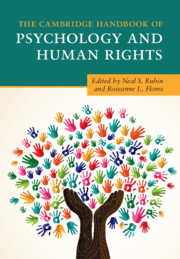Book contents
- The Cambridge Handbook of Psychology and Human Rights
- The Cambridge Handbook of Psychology and Human Rights
- Copyright page
- Dedication
- Contents
- Figures
- Tables
- Boxes
- Contributors
- Acknowledgments
- The Core International Human Rights Instruments and Their Monitoring Bodies
- Universal Human Rights Instruments
- Sustainable Development Goals
- Glossary of United Nations and Psychology Acronyms in the Handbook
- Introduction
- Part I History of Human Rights
- Part II The Intersection of Psychology and Human Rights
- Part III Contemporary Issues in Psychology and Human Rights
- Part IV Teaching, Research, and Training in Psychology and Human Rights
- Part V Future Directions
- 36 Human Rights and Reconciliation
- 37 The Australian Psychological Society’s Apology to Aboriginal and Torres Strait Islander People
- 38 The Role of Scientific Societies in Promoting and Protecting Human Rights and the Example of the American Psychological Association
- 39 Human Rights, Psychology, and Artificial Intelligence
- 40 Psychology, Human Rights, and the Implementation of the United Nations’ 2030 Agenda for Sustainable Development
- Index
- References
36 - Human Rights and Reconciliation
Theoretical and Empirical Connections
from Part V - Future Directions
Published online by Cambridge University Press: 02 October 2020
- The Cambridge Handbook of Psychology and Human Rights
- The Cambridge Handbook of Psychology and Human Rights
- Copyright page
- Dedication
- Contents
- Figures
- Tables
- Boxes
- Contributors
- Acknowledgments
- The Core International Human Rights Instruments and Their Monitoring Bodies
- Universal Human Rights Instruments
- Sustainable Development Goals
- Glossary of United Nations and Psychology Acronyms in the Handbook
- Introduction
- Part I History of Human Rights
- Part II The Intersection of Psychology and Human Rights
- Part III Contemporary Issues in Psychology and Human Rights
- Part IV Teaching, Research, and Training in Psychology and Human Rights
- Part V Future Directions
- 36 Human Rights and Reconciliation
- 37 The Australian Psychological Society’s Apology to Aboriginal and Torres Strait Islander People
- 38 The Role of Scientific Societies in Promoting and Protecting Human Rights and the Example of the American Psychological Association
- 39 Human Rights, Psychology, and Artificial Intelligence
- 40 Psychology, Human Rights, and the Implementation of the United Nations’ 2030 Agenda for Sustainable Development
- Index
- References
Summary
Reconciliation requires individuals and groups to address past and present inequality, injustice, and violence to construct better futures based on stronger social bonds and a respect for human rights. Yet, the theoretical threads connecting the concepts are rarely unraveled. This chapter uses psychological frameworks to better understand reconciliation in relation to human rights. The authors propose that in postconflict settings, reconciliation and human rights are interdependent and mutually reinforcing, and neither is truly possible without the other. First, the authors briefly review understandings of reconciliation and how they are advanced by postconflict mechanisms such as truth commissions. Second, the authors explain how reconciliation may be connected to greater respect for human rights. Third, Colombia is used as a case study to demonstrate the complex relationships between forgiveness, reconciliation, and human rights. Finally, the chapter offers future directions for research at the intersection of human rights, psychology, and reconciliation.
- Type
- Chapter
- Information
- The Cambridge Handbook of Psychology and Human Rights , pp. 537 - 552Publisher: Cambridge University PressPrint publication year: 2020
References
- 3
- Cited by

